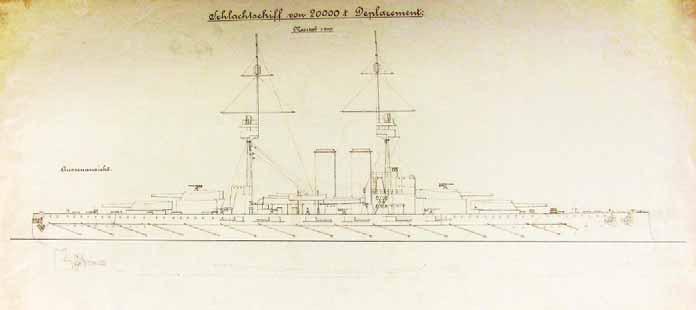the lack of vertical armor over the main belt. Based on their calculations they stated that a heavy projectile arriving at an angle of 7 degrees or more could slip above the main belt and easily penetrate the 30 mm thick Mitteldeck and the 36 mm thick armored deck one level below and reach the magazine (cartridge room). On the 24,500 ton design, unlike on the Tegetthoff s, the 35 cm magazines were directly below the armored deck and their upper parts were above the waterline.370 The Arsenal proposed thickening the Mitteldeck over the magazines of the triple turrets to 50 mm. To compensate the extra weight, they also proposed the abandonment of the upper casemate.371 Pitzinger in his 27 March report to the Marinesektion reflected only on the Arsenal’s proposal. He stated that the thickening of the Mitteldeck by 20 mm would result in reducing the thickness of the main belt, the barbettes and the conning tower to 300 mm.372 It is clearly visible that Pitzinger was sticking to the upper casemate around the conning tower and its four 15 cm guns and was reluctant to sacrifice it, but the days of the Reduit were numbered. There were many problems with the Reduit, or upper casemate. The foundations of the pivots of the 15 cm guns were weak, the ammunition supply of the guns was difficult and the fore triple turret could block the fire of the Reduit’s guns when it was trained to starboard or portside. Due to these problems on 15 April 1914 the Navy finally decided to abandon the upper casemate. With this decision the number of 15 cm guns was reduced from 18 to 14.373 The 470 tons weight saved by the elimination of the upper casemate was spent on armor thickening and structural reinforcements. The Mitteldeck over the magazines of the two triple turrets, which was an area of 1,050 square meters, was thickened from 30 to 50 mm. The armor of the barbettes between the armored deck and the Mitteldeck was reinforced, its thickness increasing from 80 to 110 mm. The transversal armored bulkheads were also reinforced as were the foundations of the conning tower and the twin turrets. The 11 mm plating of mild steel (Schiff baustahl) was changed to 40 mm reinforced plating of K armor above the bow and stern armor ranging to the portholes. The 35 cm ammunition allowance per gun once augmented from 76 to 100 rounds was reduced again to 76 due to lack of space.374 One of the reasons of the
latter was the redesign of the broadside torpedo tube rooms to accommodate the longer 7 m type torpedoes.375 When the delegations voted for the extraordinary credit in May 1914, the final design was ready to approve, with only one great test still remaining: the underwater explosion test on a test bed which represented the 1/1 scale midship section of the projected battleships. The Underwater Explosion Test It is matter of common knowledge that the deficiencies of torpedo protection system of the Tegetthoff class dreadnoughts moved the Austro-Hungarian Navy to carry out expensive underwater tests following the German example.376 To evaluate the layout of torpedo protection (torpedo bulkhead, armored deck) a 1/1 scale test bed, a hull middle section, the so called Sprengobjekt (explosive object) was constructed. All test reports were, however, disappeared from the Kriegsarchiv Vienna, allegedly an Allied fact finding team of unknown nationality carried them away and consequently the results of the test remained unknown for a long time. Fortunately, in the Archives of the Technical and Transport Museum of Budapest, some documents of the abovementioned underwater test were found including the test report.377 When Haus replaced Montecuccoli as Marinekommandant the Navy recognized the immense importance of the underwater protection against naval mines and torpedoes. In the light of the wellknown defects of the torpedo protection system of the Tegetthoff class battleships now under construction the Navy was no longer satisfied with theoretical calculations and useless experiments on models. In 1913, the Navy decided, possibly on Haus’s direct order, to execute an expensive underwater test on a test bed representing a 1/1 scale of the battleships to be built. It was a reasonable decision because the less than quarter million Kronen cost of the test was a fraction of the 328 million Kronen price of the four battleships all the more so because the test results could save an expensive battleship from sinking. The test on a 1/1 scale section of the 24,500 ton battleship was ordered by the Navy on 9 September 1913. The MTK completed the plans for
— 108 —






























